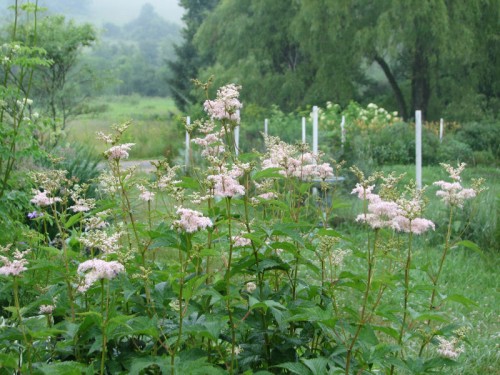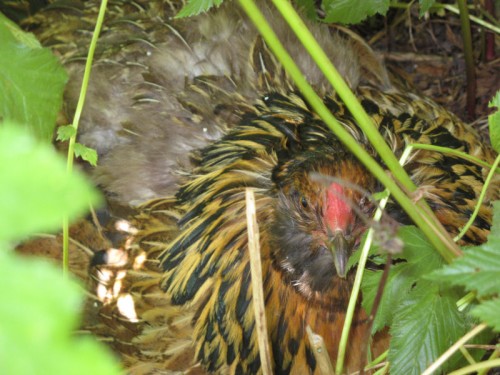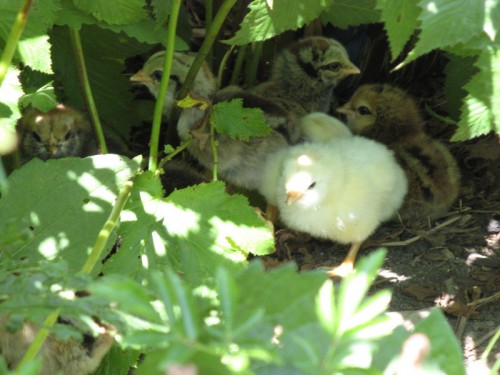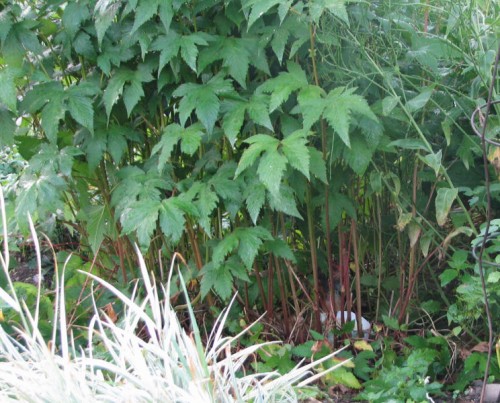This filipendula has been growing well in my garden for several years. I ordered it in the mail as Queen of the Prairie, Filipendula ‘Venusta Rubra’, but the flowers aren’t pink enough for that. In the last couple of years, I’ve noticed that although it grows vigorously, the center has died out. This is supposed to be a sign that it needs to be divided and reset, but since it grows so well that you really have to look to see the died-out center, it hasn’t exactly made it to the top of my garden to-do list.
Today the whole family learned that someone else discovered that died-out center.
One of my sharp-eyed children discovered that this particular hen had been very diligent and now had quite a bit of company:
I was clueless
I have been working in this border off and on for the past several weeks. Earlier this week I had been moving plants quite close to the nest and never guessed there was a broody hen inches away from my garden fork. A couple of times I heard a rustling noise, looked around without seeing anything, and decided it must have been the chipmunk that has been zealously collecting the sunflower seed dropped by the birds at the feeder and burying it all over my flower beds.
But no, it was Mama Hen diligently bringing her long vigil to fruition. So far we’ve managed to count nine chicks.
What kind of chick did you think I meant?








Hi Kathy, I came upon this entry just now after doing an image search for queen of the prairie; I have two but forgot where I planted them last fall, and wanted to verify they were the plants I thought they were. Which they were. Love this story about the hen, though. That’s really cool.
Monica the Garden Faerie’s last blog post..Thoughts-of-Travel Tuesday
I love it!
Wow…is that a lot of chicks for one hen?
It’s no wonder you didn’t see her, she blends in so perfectly. I do wish I could keep chickens. It’s one of those things I want to do but getting started seems to be the hardest part.
Don, since getting this filipendula, I’ve since obtained some bona fide Queen of the Prairie. The real thing blooms late, and the blossoms are much deeper pink, cotton candy pink. If my chicken nest plant is the same genus and species, it is a significant variation.
Mary Ann, your comment was so thought provoking I mulled it over for several hours. Sometimes we denigrate ourselves with excuses that aren’t really excuses. Normally I can’t rest until I know the i.d. of a plant. I did look it up in my card file, because I got that plant back when I actually kept a card file of all my plants. It’s more than 10 years old; I got it in 1994. I’m sure I’ve tried to identify it before; both palmata and ulmaria ring a bell. Looked it up in the AHS A to Z, and that’s where I drew the line. The entry on filipendulas started talking about hairy stems versus smooth, and I didn’t want to stop what I was doing to go look at my plant. But surely in the last 13 years I had time to figure it out. And maybe I did, but that information is not where I can currently find it. So, in the short term I was too busy, over the long haul I was unmotivated, because the plant has never given me any concern or worry. Is unmotivated the same thing as lazy?
This particular example aside, your point is well taken. I’ll be watching my words about myself to see if they mesh with the truth.
Yes, Molly, I tried to work “hens and chicks” into my blog title, but couldn’t word it so it didn’t sound awkward. Finally decided to leave it more ambiguous. It’s not the first time it’s happened to us, either, but it was the first time I was that close to a broody hen and didn’t even know it.
Most people, when they say they have “hen and chicks” in their garden are referring to small rapidly reproducing succulents. 🙂 I’ve had hens that would disappear for weeks at a time and then come out of some neglected corner of the property with a bunch of babies. I love it.
That’s a great addition to your flock. Congratulations. I wonder what the white ones will look like when they grow up.
Years ago, actually decades ago I noticed that I was frequently excusing myself for not attending to little details by saying I was lazy. One day I realized I’m not lazy at all, just very, very busy. I’m sure the same is true for you and Ted.
Your hen chose a pretty spot for her nest – I used to grow Filipendula ulmaria, with cream-colored flowers- it was also called Queen of the Meadow but was probably less than 2-feet in height.
Is a nest with a dozen chicks common, Kathy? It sounds like a lot to keep track of!
Annie at the Transplantable Rose
I dunno… I supposedly have rubra too, and mine is also kind of a soft pink like yours. You never know eggsactly what you’re getting.
How lucky are you! What a smart hen to find a place so close and hidden. Someday I want some chickens. Not til retirement which is a while off! Enjoy the weekend!
Hi Kathy,
Well, I must say that is a unique experience!
Thanks for letting me know the article published. I don’t get that magazine any more, but will look for it this weekend.
I had one comment today stating she came from your article. How exciting!
I thought you meant the Dixie Chicks, of course ! Just kidding. The hen is gorgeous and the chicks very cute. I can’t believe she had 13 live ones. That’s amazing.
She took them off the nest to go scratching so we knew she was done setting. Final count: 13 live chicks, 3 unhatched eggs. We just moved her into the chicken yard, and she’ll probably stay there, since her chicks can’t fly over the fence like she obviously was doing.
Thanks – I knew it had a ‘u’ in it but I was too lazy to look it up.
If I tried to take a chick out from under her, she would try to peck me, but that would be nothing like a wasp sting. She and her brood are going to be relocated inside the chicken yard as soon as we are sure all the eggs that are going to hatch have hatched. Yesterday morning we could still see a few unhatched eggs, and we are not sure if they are Johnny-come-latelies or duds.
I’m glad I’m not the only one who crawls around in the garden not seeing what is right there in front of me sometimes. Then later I go back and find out I was gardening a foot away from a paper wasps nest or something like that. At least the chicken wouldn’t hurt you, right?
What you are trying to spell is Araucana. Ours are not bona fide Araucanas, but are either Ameraucanas or Easter Eggers. They were ordered as chicks last year and I don’t remember what the catalog called them. To tell you the truth, I don’t have much to do with the chickens until they get in the kitchen, and all the people who would know for certain aren’t home right now.
Thanks for the plant hint. I could probably figure it out if I took the trouble to key it out, but so far I’ve been too lazy. (And I’ve probably had this plant for ten years!)
Very cute photos! We had a broody hen for a while but no rooster. The poor thing would lay clutches of eggs that never got to hatch. She would come up with some crazy locales.
Is the hen a aracona (sp?). She looks a lot like one of ours.
The filipendula may be F. palmata aka Queen of the Meadow. The european version of our queen of the prairie.